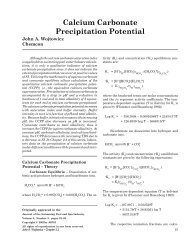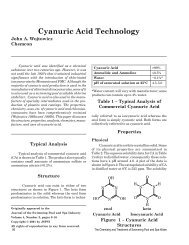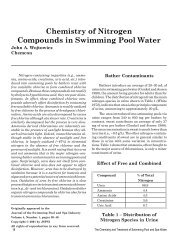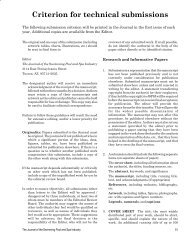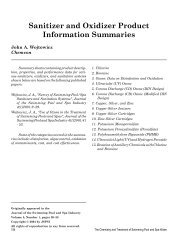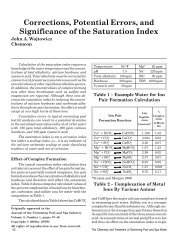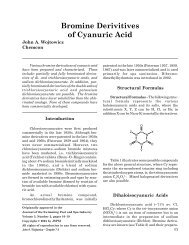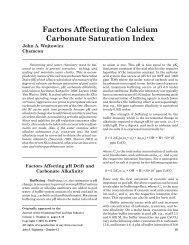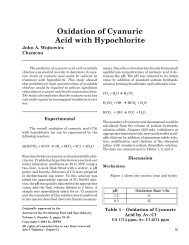Relative Bactericidal Effectiveness of Hypochlorous Acid and ...
Relative Bactericidal Effectiveness of Hypochlorous Acid and ...
Relative Bactericidal Effectiveness of Hypochlorous Acid and ...
- No tags were found...
Create successful ePaper yourself
Turn your PDF publications into a flip-book with our unique Google optimized e-Paper software.
In order to apply Andersen’s data to swimmingpool conditions, the data must be adjusted for theeffect not only <strong>of</strong> temperature but pH as well. Since killtime varies inversely with pH (which influences theHOCl concentration), the 99% kill time at pH 7 <strong>and</strong>20°C was first adjusted to pH 7.5 (typical in swimmingpools) by multiplying by the factor 1.40, which representsthe ratio <strong>of</strong> HOCl at pH 7 to that at pH 7.5 instabilized water. Cyanuric acid moderates the effect <strong>of</strong>pH on the HOCl concentration since the factor inunstabilized water is 1.48.t 0.99(pH 7.5 <strong>and</strong> 20°C) = [0.167 + 0.0722Cy T/Cl T]/qThe factor q allows extrapolation <strong>of</strong> kill timesfrom 20°C to other temperatures. The higher thetemperature, the higher the value <strong>of</strong> q <strong>and</strong> the lowerthe kill time. At a swimming pool temperature <strong>of</strong> 80°F(26.7°C), q = 3.29 which corresponds to 99% kill times<strong>of</strong> 0.6 – 0.2 minutes over the recommended free av. Clrange <strong>of</strong> 1 – 3 ppm at 25 ppm cyanuric for entericbacteria such as S. faecalis. Higher cyanuric acidconcentrations will cause the 99% kill times to increase.By contrast, higher temperatures, especiallyin spas, will decrease kill times.Effect <strong>of</strong> Swimming Pool Contaminants onDisinfection Rate – Longer kill times were observedin pool water, compared to distilled water, whethercyanuric acid was present or not (Swatek et al 1967).This was attributed to unknown variables, which inreality are swimming pool contaminants. In swimmingpools, nitrogenous compounds such as ammonia,amino acids, <strong>and</strong> creatinine, introduced by bathers,can react with free av. Cl. This forms bactericidallyineffective combined chlorine, resulting in increasedkill times. Combined chlorine compounds do not hydrolyzeto a significant extent to HOCl. Thus, it isimportant to maintain a low combined available chlorinelevel by frequent superchlorination or shock treatmentin order to oxidize chlorinated compounds suchas monochloramine, N–chloroamino acids, <strong>and</strong> N–chlorocreatinine, which are much poorer disinfectantsthan HOCl.Addition <strong>of</strong> ammonia to stabilized aqueous av. Clresults in increased kill times proportional to theamount added (Fitzgerald <strong>and</strong> DerVartanian 1967).By contrast to ammonia, urea, a major swimming poolcontaminant, does not affect disinfection in short termexperiments (Fitzgerald <strong>and</strong> DerVartanian 1967).Although urea is a potential source <strong>of</strong> ammonia, itshydrolysis is very slow under swimming pool conditions.However, since urea serves as a nutrient forbacteria <strong>and</strong> algae, it is necessary to oxidize it byperiodic shock treatment.ReferencesAndersen, J. R. “A Study <strong>of</strong> the Influence <strong>of</strong> Cyanuric<strong>Acid</strong> on the <strong>Bactericidal</strong> <strong>Effectiveness</strong> <strong>of</strong> Chlorine.”American Journal <strong>of</strong> Public Health 1965, 55, 1629–37.Brady, A. P., K. M. Sancier, G. J. Sirine. “Equilibria inSolutions <strong>of</strong> Cyanuric <strong>Acid</strong> <strong>and</strong> its ChlorinatedDerivitives.” Journal <strong>of</strong> the American ChemicalSociety 1963, 85, 3101–4.Fair, J. M., J. C. Morris, S. L. Chang, I. Weil, R. P.Burden. “The Behavior <strong>of</strong> Chlorine as a WaterDisinfectant.” Journal <strong>of</strong> the American WaterWorks Association 1948, 40, 1051–1061.Fitzgerald, G. P., M. E. DerVartanian. “FactorsInfluencing the <strong>Effectiveness</strong> <strong>of</strong> Swimming PoolBactericides.” Applied Microbiology 1967, 15, 504–509.Gardner, J., “Chloroisocyanurates in the Treatment<strong>of</strong> Swimming Pool Water.” Water Research 1973,7, 823–33.Green, D. E., P. K. Stumpf. “The Mode <strong>of</strong> Action <strong>of</strong>Chlorine.” Journal <strong>of</strong> the American Water WorksAssociation 1946, 38, 1301–5.Morris, J. C. “The <strong>Acid</strong> Ionization Constant <strong>of</strong> HOClfrom 5 to 35°.” Journal <strong>of</strong> the American ChemicalSociety 1966, 70, 3798–3805.Nelson, G. D. “Special Report No. 6862 – SwimmingPool Disinfection with Chlorinated–s–triazinetrione Products.”, Monsanto Chemical Co.,St. Louis, Missouri, March 1967.O’Brien, J. E., J. C. Morris <strong>and</strong> J. N. Butler in Chemistry<strong>of</strong> Water Supply, Treatment, <strong>and</strong> Distribution.(Ann Arbor, Michigan: Ann Arbor SciencePublishers, Inc. 1972) pp. 333–358.Pinsky, M. L.; H–C Hu. “Evaluation <strong>of</strong> theChloroisocyanurate Hydrolysis Constants.”Environmental Science <strong>and</strong> Technology 1981, 15,423–30.Stewart, L. S.; L. F. Ortenzio. “Swimming Pool ChlorineStabilizers.” Soap <strong>and</strong> Chemical Specialties 1964,40, 79–82, 112–13.Swatek, F. E.; H. Raj; <strong>and</strong> G. E. Kalbus. “A LaboratoryEvaluation <strong>of</strong> the Effects <strong>of</strong> Cyanuric <strong>Acid</strong> on the<strong>Bactericidal</strong> Activity <strong>of</strong> Chlorine in Distilled Water<strong>and</strong> Swimming Pool Water.”, Paper presented atNSPI Convention, Las Vegas, NV, 1967.Wojtowicz, J. A. “Re–evaluation <strong>of</strong> ChloroisocyanurateHydrolysis Constants.” Submitted for review <strong>and</strong>publication to the Journal <strong>of</strong> the Swimming Pool<strong>and</strong> Spa Industry 1996.John A. Wojtowicz – Chapter 6.1 111



